by Lisa Di Tommaso | May 10, 2022 | Blog
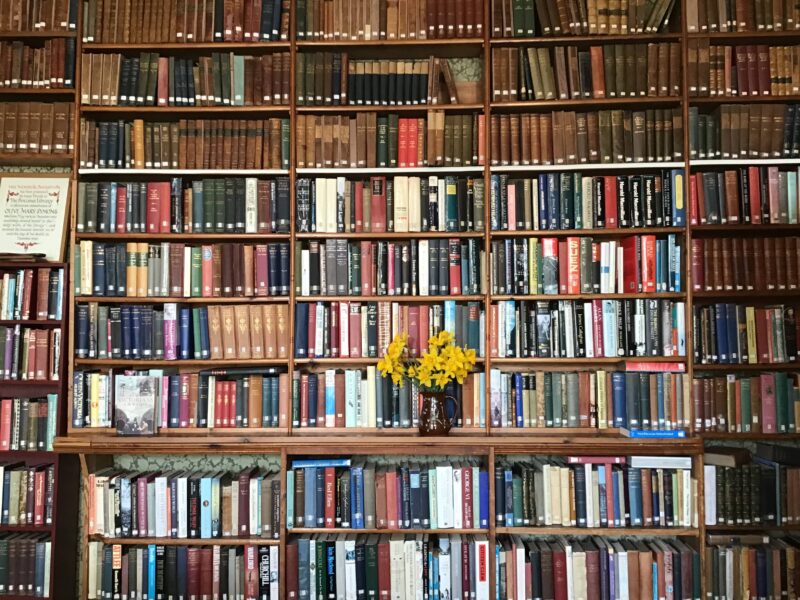
Being a trustee is a voluntary role and we welcome applications from people from all walks of life. It is not necessary for trustees to be expert in all areas of governance but we have to ensure that collectively the Management Committee has the skills and experience to operate effectively and to support the Librarian and her team. Training and support is available through our membership of the National Council for Voluntary Organisations, where our trustees have access to up to date information and a range of learning opportunities.
From time to time we conduct a skills audit of all our trustees and, at the moment, we are especially looking for people with experience in finance, PR, HR, building & construction and IT.
All members of the management Committee:
- Commit to the core vision of the Morrab Library to inspire members of the community through books, archival materials and events within a unique tranquil space for learning, reflection, creation and making new connections;
- Contribute their skills and expertise to the Management Committee’s collective decision making;
- Positively promote the Morrab Library and act as an advocate for the organisation;
- Support the Library’s income generation initiatives including the search for external funding;
- Accept the legal duties and responsibility of trusteeship;
- Devote the necessary time to the role, including attending Zoom and face to face meetings, supporting the Librarian and, on occasion, attending events.
The trustees meet on the first Tuesday of every month either by Zoom or in person. Working groups are occasionally formed for specific projects and meet on an ad-hoc basis.
If you are interested in joining our team we would very much like to hear from you. Please email our Secretary, Paget MacDonald at secretary@morrablibrary.org.uk if you would like to find out more about us, let us know about your skills, and why you are interested in joining us.
Best wishes from the Management Committee at Morrab Library
by Lisa Di Tommaso | Mar 12, 2022 | Blog
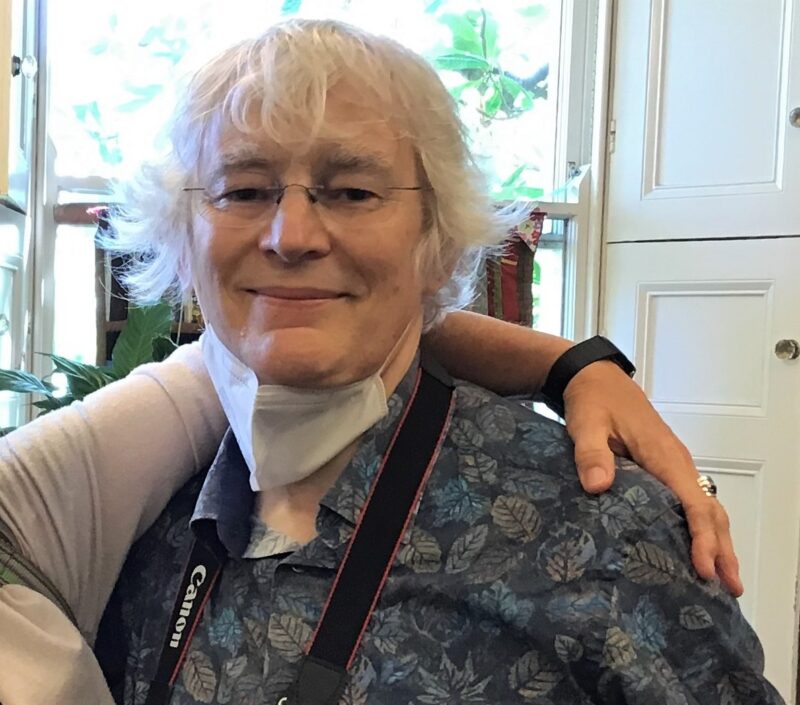
It is with the saddest of hearts that we need to share the news that our much-loved life member, volunteer and former Trustee, Stephen Clark, passed away on the 2nd of March.
It is no exaggeration to say that Steve loved the Morrab Library. Having joined in 2018, he threw himself in at the deep end, volunteering for reception desk duty not once, but twice a week, where he welcomed visitors, suggested all sorts of interesting book titles to borrowers, and practised his language skills with particular members too.
Steve soon became a member of the library’s Book Selection Committee where he made brilliant suggestions to enhance the library’s collections, particularly in the areas of science and poetry. He stuck to his guns when the rest of the Committee occasionally questioned any of his choices, delivering eloquent and passionate arguments in their favour, and more times than not, winning.
When the library started a new Poetry Group, a fortnightly opportunity for members to discuss a different poet, Steve was an active participant. Much to the joy of his colleagues at these meetings, Steve arrived with a freshly baked cake, it’s flavour based on the nationality of the poet who was being discussed that week. Steve’s cakes also made regular appearances at library events – our fairs and fetes, Christmas parties and more. While all of these cakes were delicious, his Simnel cake was out of this world!
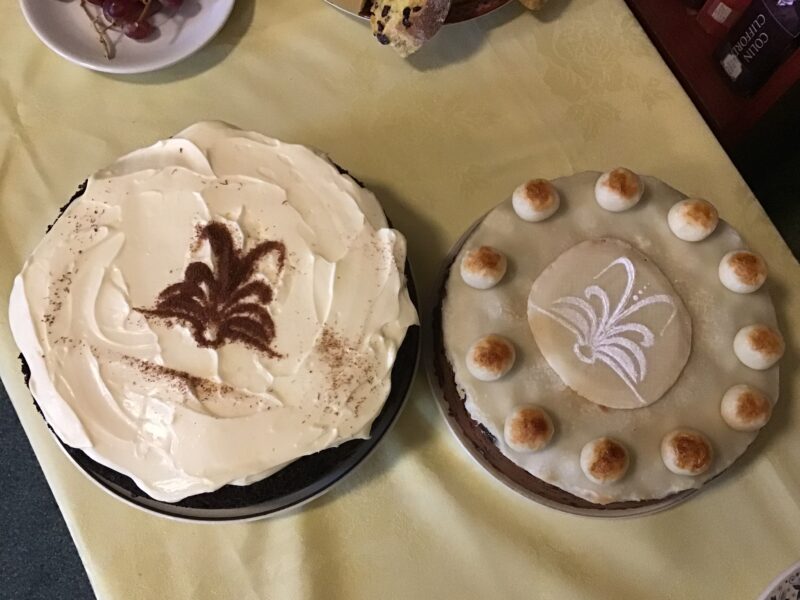
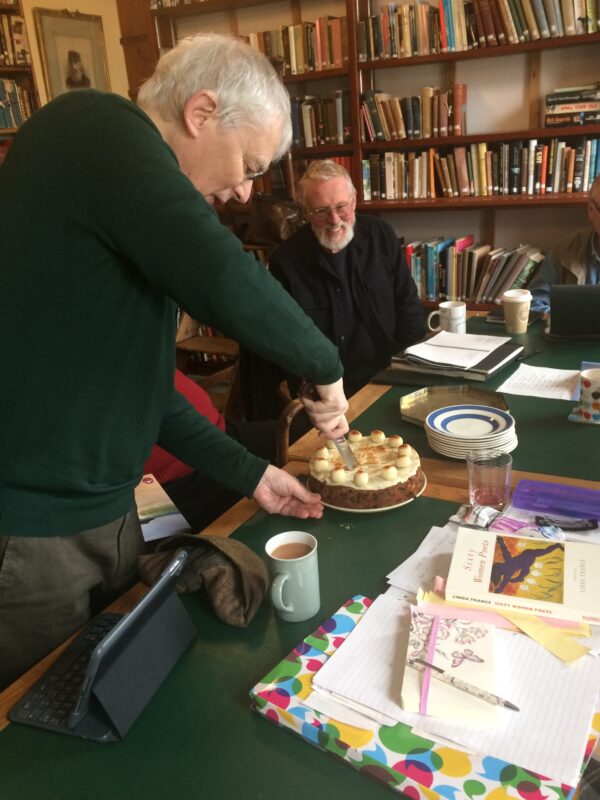
Many who attended the Library’s Christmas Party in 2019 will remember Steve’s acting skills too, when he played the role of former Library President, J A Hamilton, in the performance of Camidge & Stringer’s ‘Remembering the Morrab Library in 1919’.
Importantly, Steve’s love for the library ultimately manifested itself when he joined the Management Committee. In his own words:
“When you are in love, you want to do things for the object of your desire. So when, five months after joining the library, I was asked to join that mysterious body, the Management Trustee Committee, as Honorary Secretary I accepted. It has to be said that I agreed with some trepidation at first; I was still very starry-eyed about the Morrab and really had no idea of the responsibilities of the secretary, still less what the Management Trustees actually did. Being a Trustee is a privilege and a responsibility. It is like being behind the scenes with the production team in a theatre. We are there to keep the building in good shape, from the state of the roof to making sure that the plugs and fire alarms are tested, and the Wi-Fi system works. We appoint the staff and work with them to fulfil the current needs and future plans of the library. Overall, it’s been a fascinating and an immensely rewarding experience to feel that I have contributed something to not only keeping the Morrab going but also to shaping its future. I’m still in love.”
Finally, we’d like to share Steve’s reflections on his favourite room in the library – the Hedgeland. Perhaps those who knew Steve may like to pause and reflect when visiting here, and remember him fondly:
“I have a particular affection for the Hedgeland room. I feel it doesn’t have to stand up to the claims that the neighbouring literature room has for the best view and the most comfortable chair. It’s as if the attention is more inward looking to the room’s true purpose – the books and not the distracting view. And what books! The range of subjects in this room is astonishing: from espionage, sociology, through fairy tales to naval history, games, theatre, music. The list could go on for ever. If your work doesn’t hold your attention or you need some distraction, just browse the wondrous shelves. I love the shape of the room too, unlike the literature room you are not there immediately; you pass through the door but there is a short passage giving a sense of mystery and then a surprise as the whole room is laid out before you. “
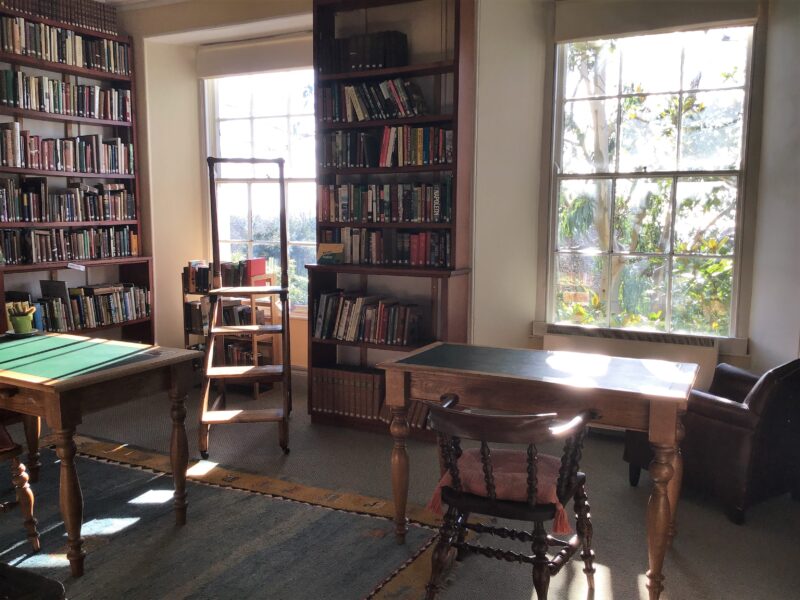
Steve was a generous and warm friend to so many of us at Morrab Library. His passion and enthusiasm was always evident, and he shared this with all he came into contact with. He had a gentle and ironic sense of humour. He was a true renaissance man – sharing with us his scientific knowledge, and his poetry writing, as well as his profound knowledge and love of literature. And cricket too.
Steve will be sorely missed by so many of us, but we know that a part of Steve’s heart will always remain here in Morrab Library, and his legacy will endure.
by Lisa Di Tommaso | Feb 9, 2022 | Blog
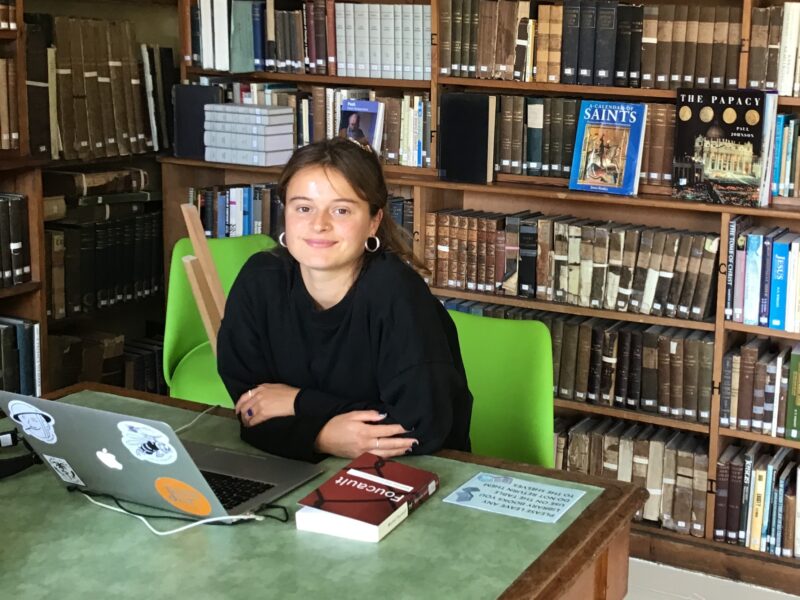
In the summer of 2021, Morrab Library hosted Eliza McCarthy, an intern from the Penryn campus of Exeter University who funded Eliza’s project through their Access to Internships programme. Eliza is an English Literature student and spent her time exploring the library’s archive relating to John Thomas Blight (1835-1911), Cornish archaeologist and artist. Blight found himself incarcerated in the Bodmin Mental Asylum, and Eliza’s paper explores Blight’s life and the wider issues around the care of people with mental health problems at that time.
It was a delight to host Eliza, and the results of her hard work are evident in the paper she wrote, which is reproduced here, and will be added to the JT Blight Archive collection for future researchers.
by Lisa Di Tommaso | Dec 27, 2021 | Blog, Uncategorized
In the midst of lockdown over 2020 and 2021, Morrab Library was contacted by Alison Shell, Professor of Early Modern Studies at University College London. She had come across a brief citation to an item in our Archive collection, created by the late John Simmonds, who, over twenty years, had created a record on paper of all our holdings – an extraordinary piece of work when you consider we hold more than 5,000 records.
Alison’s curiosity was piqued by this record – all John, and his colleague the notable author and historian P.A.S Pool, had been able to unearth about this unassuming slim volume:
MOR/MAN/5 – ” a volume written in Latin of the texts of several religious plays in the 17th or early 18th century hand. The subjects include King Canute, Earl Godwin and the prophet Mahomet (portrayed as the Antichrist). A gift of the Reverend James Halliwell (1862). Brown leather, bound, 16cm”
She made the long journey from London to visit the library and examine the volume, and her efforts were rewarded with a truly remarkable discovery. Read Alison’s blog to find out more…
A volume of 17th-century Latin plays written by English Catholics, almost certainly at the English College at St Omer, has recently been discovered in the Morrab Library collections (1).
During the reign of Elizabeth I, when it became clear that England would remain Protestant for the foreseeable future, expatriate English Catholics grew increasingly concerned to preserve their faith for successive generations. To this end, they set up educational institutions in continental Europe, of which the English College at St Omer, or ‘St Omers’ – the forerunner of Stonyhurst College in Lancashire — is one of the best-known. Catering mostly for school-age boys, it was run by the Jesuit order, well-known across Europe for its educational efforts. Jesuits knew how effectively drama could develop oral fluency, confidence and memory skills in their charges, and — anticipating present-day educators — made considerable use of it as a teaching aid. Their productions also functioned as a public relations exercise when mounted for distinguished visitors or the local community, often deploying music, dance and spectacle to show off the students’ abilities. Most of all, they promoted the ideals of Counter-Reformation Catholicism in an attractive and imaginatively compelling manner – not least among the young actors themselves. (2)
An important part of the Order’s missionary endeavour, Jesuit drama had an international reach through Catholic Europe and even beyond. Yet it was very much coloured by national concerns, as the present volume demonstrates. Even though its English writers and actors were living and working outside England, they were passionately committed to bringing their mother country back within the Catholic fold. Two plays in the present compilation draw on English history: the tragedy Canutus magno maior (Canute, greater than the great) dramatizes the life of King Canute, the other, Godwinus, is shaped round historical anecdotes about Godwin, Earl of Wessex. The volume also features another tragedy, Clearchus furens (Clearchus raging); an apocalyptic play in which Christ clashes with Mohammed; an untitled dialogue with characters including an angel and a poet; and the allegorical drama Philander, sive Angelus custos (Philander, or The Guardian Angel) (Fig.1). The latter play is signed by Francis Biddulph, a student at St Omers between 1664 and 1670. (3) (Fig.2). Since English Jesuit plays rarely travelled between colleges and had relatively little currency outside them, this makes it overwhelmingly likely that the manuscript was a St Omers production. The inclusion of Biddulph’s work also suggests that the volume was compiled in the mid- to late 1660s, though Philander might still have been read after Biddulph had left St Omers.
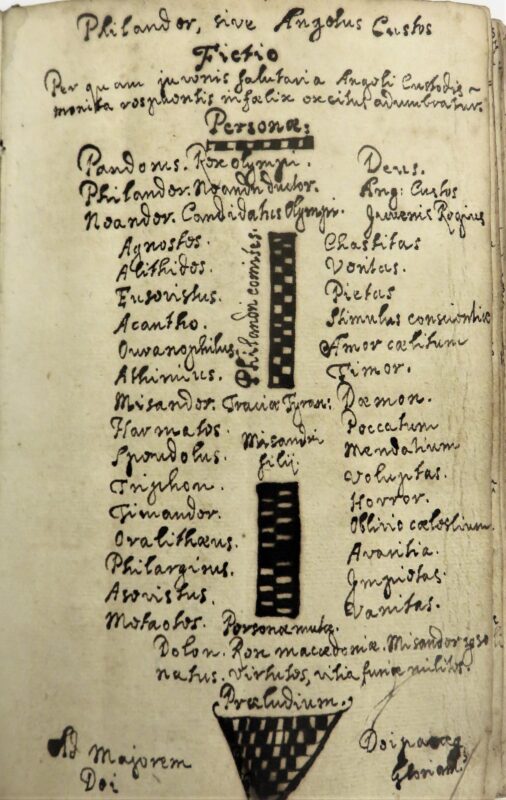 Figure 1
Figure 1

Figure 2
The volume was most probably compiled for reading rather than performance, though it is likely that the plays themselves were put on in some form. The play about Christ and Mohammed may be the apocalyptic drama of which the St Omers register records a performance in 1669, another reason to attribute it to the College (4). No evidence has yet been found of the other plays’ production, but this is not surprising; the dramatic culture of St Omers encompassed everything from classroom performance upwards, and much of it was ephemeral. The more prestigious a production, the more likely it was to be recorded, but even for plays of this kind, records are incomplete and unsystematic. It is unusual, though, for more than one copy of a St Omers play to survive, and the fact that a British Library manuscript also contains copies of Canutus and Clearchus suggests that these particular dramas were relatively high-profile and well regarded (5).

The manuscript came into the Morrab Library as part of a donation of seventeenth- and eighteenth-century playtexts from the Shakespeare scholar James Orchard Halliwell (later Halliwell-Phillipps) (Fig.3, above). One item in his correspondence with the library contains an undated list of books and manuscripts that mentions Canutus and Clearchus (6). Halliwell-Phillipps was a generous donor to repositories, including the Shakespeare Birthplace Trust in Stratford-upon-Avon, Chetham’s Library in Manchester and the Smithsonian Institution in Washington; he had a particular love of Penzance, where he frequently holidayed. He was awarded the freedom of the borough for his patronage, and a bookcase in the Morrab Library bears his name to this day (7) (Fig.4). Seven decades after his death, in 1964, the Library put the bulk of his collection up for sale at a time of financial difficulty, and the collection was dispersed: mostly to Edinburgh University Library, another institution that had benefited from Halliwell-Phillipps’s patronage (8). The St Omers plays were not included, most likely because they were not considered worth selling. Perhaps they were thought to be extraneous to English dramatic history, or peripheral within Halliwell-Phillipps’s collection — or perhaps the Latin was off-putting. But the oversight has had the happy result of preserving this rare and compelling find within the Morrab’s own collections.
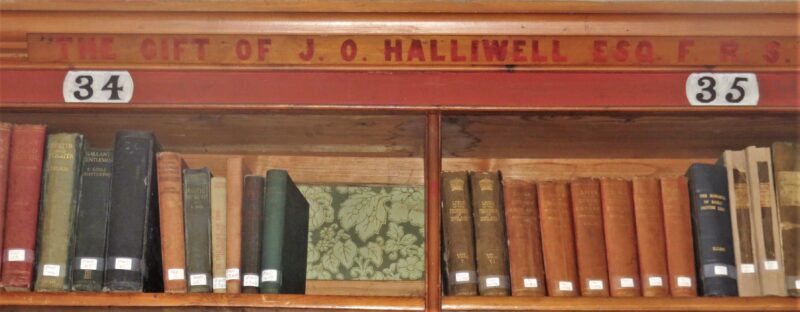
Figure 4
(With thanks to Lisa Di Tommaso; Arnold Hunt; Joe Reed, Archivist at Stonyhurst College; and the Leverhulme Trust for funding my archival research through a Major Research Fellowship.)
Alison Shell (Professor)
Department of English
University College London
FOOTNOTES
1: Morrab Library, MOR/MAN/5.
2: William H. McCabe, SJ., An Introduction to the Jesuit Theater. Ed. Louis J. Oldani, SJ. (St Louis: Institute of Jesuit Sources, 1983), and Paul Shore, ‘Counter-Reformation Drama’, ch.19 in The Ashgate Research Companion to the Counter-Reformation, ed. Alexandra Bamji, Geert H. Janssen and Mary Laven (Farnham: Ashgate, 2013).
3: Geoffrey Holt, SJ. St Omers and Bruges Colleges, 1593-1773: A Biographical Dictionary (S.l. Catholic Record Society, 1979), p.36. For biographical details of another, earlier Francis Biddulph, see Thomas M. McCoog, S.J., English and Welsh Jesuits, 1555-1650: Part 1, A-F, Catholic Record Society, vol.74 (London: Catholic Record Society, 1994), p.170.
4: McCabe, p.99.
5: BL Add MS 41182.
6: Morrab Library, Halliwell-Phillipps correspondence (MOR/LIB/20a).
7: Arthur Freeman and Janet Ing Freeman, ‘Phillipps, James Orchard Halliwell- (1820–1889), Oxford Dictionary of National Biography, online; The Cornishman, 19 October 1893, p.6.
8: Cyril Noall, The Penzance Library, 1818-1968 (Penzance: Penzance Library, 1968), pp.28-9; ‘In the Saleroom’, Times Literary Supplement, 30 July 1964.
by Lisa Di Tommaso | Dec 22, 2021 | Blog
Alison Meaton is a Penwith resident, a retired primary school teacher, a Quaker and part of Extinction Rebellion West Cornwall. She is also a new member of Morrab Library. In late October 2021 she travelled up to Glasgow for COP26 to be part of the surge of people bearing witness to the climate emergency.
We contacted Alison as we felt that the voice of a Penwith resident on the ground at COP26 would be an invaluable addition to the Penwith Futures Book project. As Alison journeyed north, and during her time on the ground in Glasgow, she kindly shared daily photos and diary entries with us to paint a picture of how it felt to be part of this pivotal moment in history.
Alison will be contributing to the Penwith Futures Book which you will be able to read in a year’s time. In the meantime, we thought we would share excerpts from her daily thoughts live from COP26. Perhaps they might inspire you to reflect upon COP26 and the changes you hope to see here in Penwith. And to think about your ideas for the future and get creative in your entries to the Penwith Futures Book.
30th October
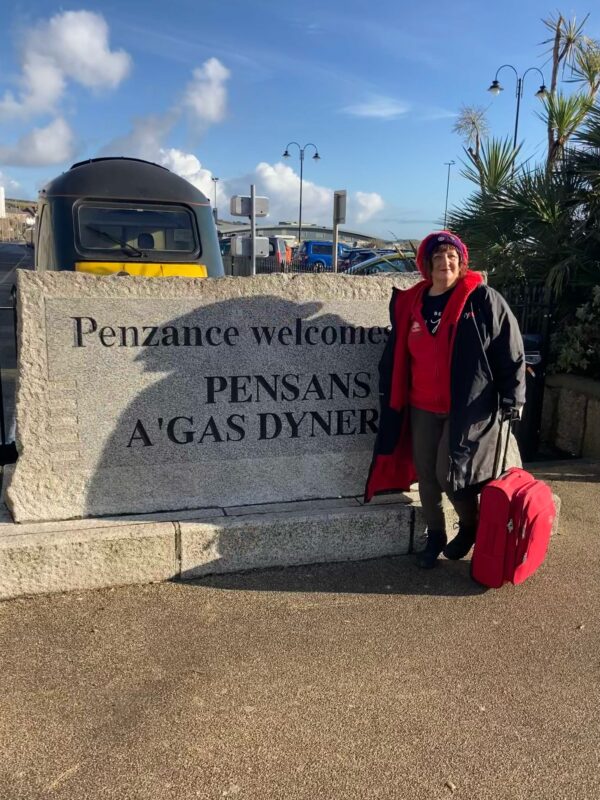
“I am embarking on a 560-mile train journey to Glasgow with my case crammed full of banners, flags and thermals. Leaving balmy Penzance, dressed for comfort rather than style, I am overheating. Glasgow is significantly colder and I’ve been advised to prepare for wet weather. On the train my phone is constantly showing new messages with requests for people to join marches, prayer vigils, actions and visit art events. This feels like a holiday but I know there is a serious purpose. I am going to COP26 to bear witness to the climate emergency. I am driven to be there to show the world leaders and decision makers that individuals, the worker ants, demand real action with commitments to limit global temperature rise to 1.5°C. They are accountable to us and our future generations.”
31st October

“I walk on the pedestrianised grid of streets orientating myself in this unknown city. I notice a few activists, recognisable by their rucksacks and badges. There is a large interfaith vigil with representatives leading prayers and meditations for those making decisions at COP26.
Glasgow Quaker Meeting House is providing a space to mentally and physically replenish oneself. I join a FWCC (Friends World Committee for Consultation) event hosted by Quakers in Glasgow.
Quakers from around the world share what is happening in their countries with the climate emergency and their hopes for the future. The Quaker from the Philippines speaks of the need for the world leaders at COP26 to listen to the scientists, to follow the science and stop blaming individuals, rather than the fossil fuel companies, for the dangerous position the earth is in.
I stay for the early evening reflection which steadies and calms my thoughts.”
31st November
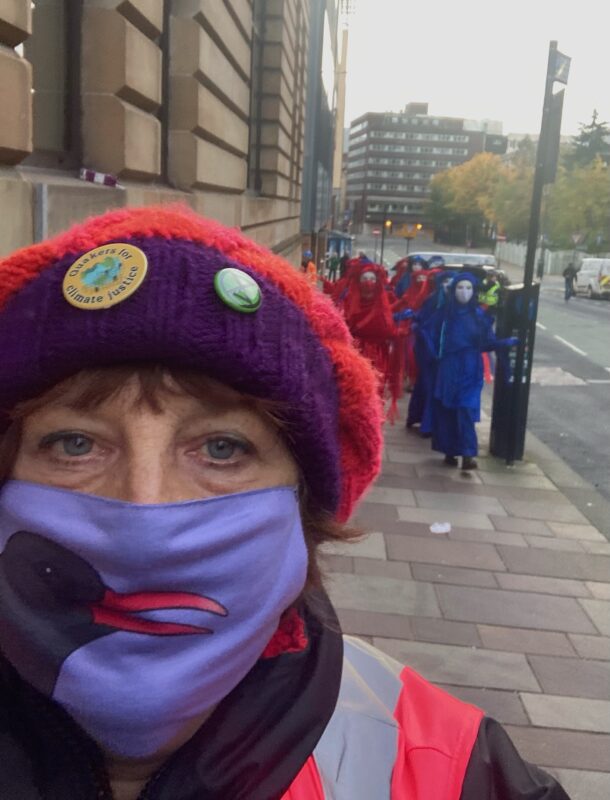
“The Red Rebels are arriving. These enigmatic figures appear without warning, moving silently among humanity.
“Red Rebel Brigade symbolises the common blood we share with all species,
That unifies us and makes us one.
As such we move as one, act as one and more importantly feel as one.
We are unity and we empathise with our surroundings, we are forgiving
We are sympathetic and humble, compassionate and understanding,
We divert, distract, delight and inspire the people who watch us,
We illuminate the magic realm beneath the surface of all things and we invite people to enter in, we make a bubble and calm the storm, we are peace in the midst of war.
We are who the people have forgotten to be!”
I am asked to help steward to keep performers safe and to ensure clear pathways for the public when in crowded places. We walk to a meeting point and the Red Rebels, accompanied by the Scottish Blue Rebels, glide out onto the pavement. Slowly, with purpose, the Red and Blue figures advance along the pavements, looking neither left or right accompanied by a single drummer. They advance with the stewards skittering around them to clear pathways, halt traffic and reassure police
Somehow the media is awakened and camera crews appear eager to film and photograph the Red and Blue tableau as they reach Glasgow Central station. Without warning the figures regroup and glide to a new resting place. And move again. Like a restless but slow-moving sloth. All the while the insistent rhythm of the drum sounds throughout the building.
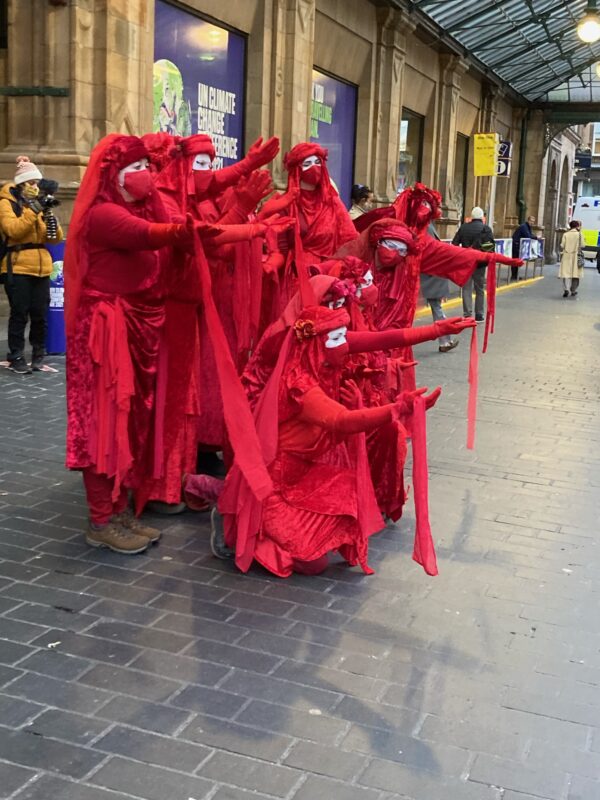
At a signal we stewards are sent off to meet the Euston train. Emerging from the crowd of travellers is a second group of Red Rebels making their stately way to the main concourse. We scurry ahead to clear a path and the 2 groups meet, create new arrangements and then without a sound turn and retrace their steps out of the station.
What an experience.”
5th November
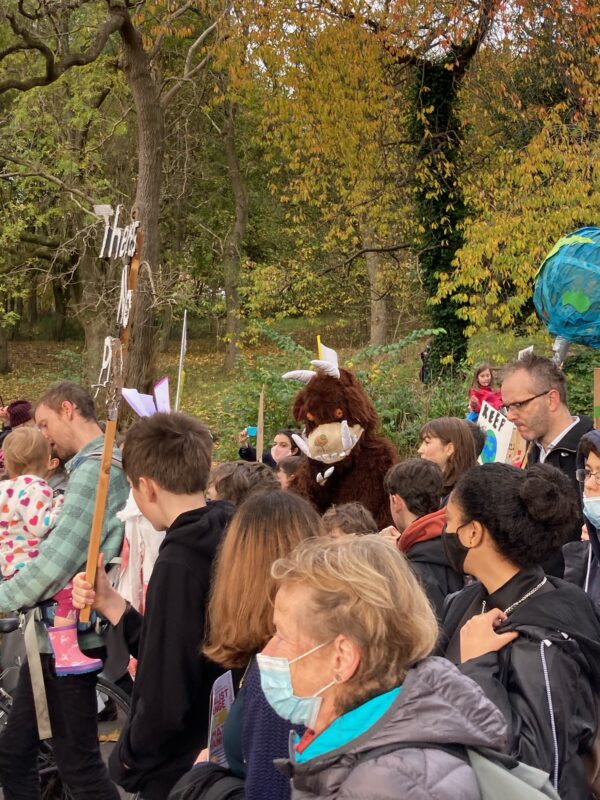
“This is the young adults and children’s march Fridays For Future and Extinction Rebellion are there to support them.
Three of us take the subway to the centre of Glasgow. We are met by the stage manager who needs three people to stand by the barriers to monitor who is coming in and out of the backstage area.
Delegates begin to arrive. I am not briefed on who is allowed in but a helpful Spanish speaking steward from another activist group works with me. I defer to him as it is a Fridays For Future event, not Extinction Rebellion. Another steward joins us and we share biscuits and climate activism stories. We muddle through with a lovely Glaswegian man who came to find out what the fuss was about and ended up staying for the whole event, moving the metal fence open and shut as needed.
We hear the march arriving before we see anyone. The samba band is playing, rhythms that enthuse, inspire, call to the soul. A sea of flags and placards advances and the square fills. Climate activists from around the world including, Ayidha Saddiqa, Chris Mitchel, Mikaela Loach, Sofia Gutierrez, Vanessa Nakate and Greta Thunberg speak calling on global governments to commit to real climate action. And then it is over. Greta Thunberg is whisked away and I say goodbye to my new friends; the Glaswegian, the Spanish speaking steward and the student from Preston who travelled up for the day to join the march.”

by Lisa Di Tommaso | Dec 14, 2021 | Blog
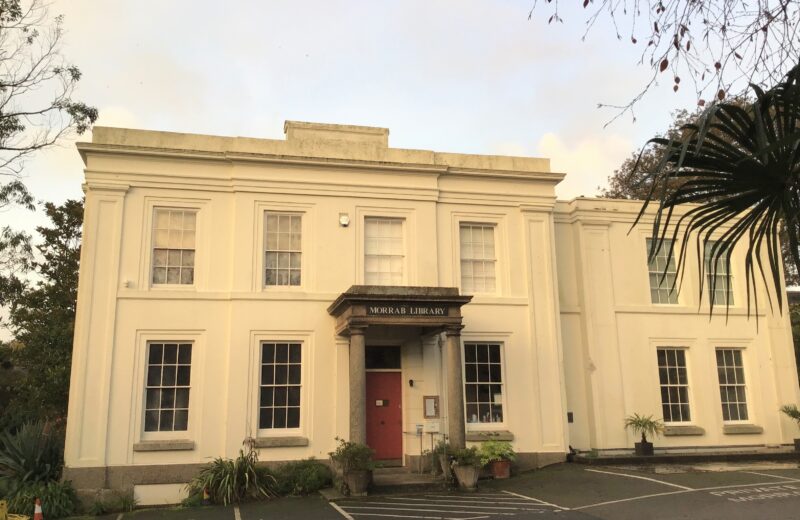
Among the many fascinating items displayed inside the Morrab Library is a bill of sale dated 1887, detailing the accommodation offered at Morrab House. Some of the rooms and stairways are easy to identify, some not, and there seems to have been a certain amount of double counting with regard to bed and dressing rooms… but hey, that’s the property business.
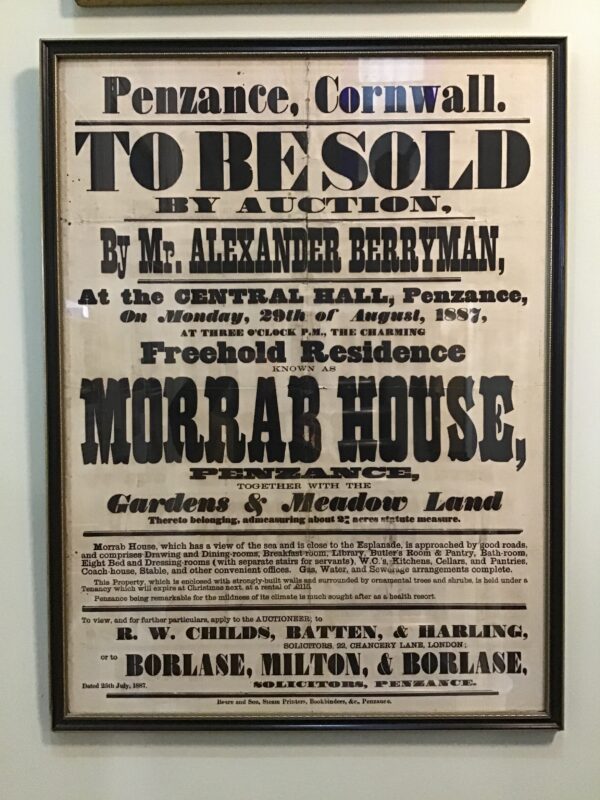
This was the building and land that would later be purchased by Penzance Town Council, keen to establish a garden for the pleasure of residents and the better class of tourist – and in the process acquiring the house, more or less by accident.
The original owner, Samuel Pidwell, had been a notable man. Educated at Oxford, in his youth he had made an early ascent – the 17th – of Mont Blanc. Back in Penzance, he married his cousin Ann Batten. The couple, two children (four more would follow later), Ann’s sister and four servants built themselves a brand new house in Morrab Fields, with a clear view out into the Bay and westwards to Penlee Point. Samuel Pidwell, although describing himself as a brewer, had considerable investments in mining. Before his death in 1854, aged only 46, he served twice as mayor, and was prominent in the Royal Geological Society of Cornwall.
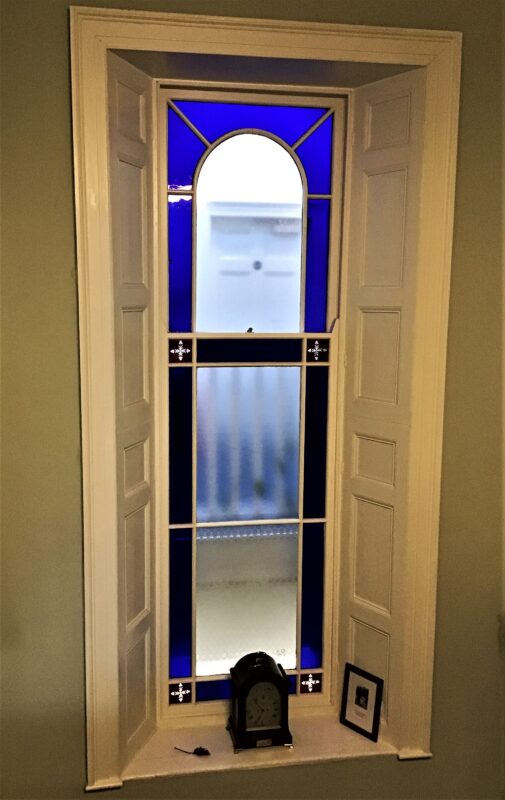
Later, the house was owned by Charles Ross. 150 years on, he is known principally for the bridge that still bears his name, and his supporters would point to the development of Morrab Road as further evidence of his goodwill and forward thinking. But in his own time, Charles Ross had other claims to fame: as the developer of Newlyn harbour, thereafter as the Conservative MP for St Ives constituency, and finally – in 1896 – for misjudgements that led to the spectacular collapse of the Batten, Carne and Carne Bank.
And so the Corporation acquired – at a cost of £3,120 – a fine building and surrounding land. The Town Council enthusiastically set about developing the grounds, but decided that the house should be leased out. The YMCA – at this date, identified with education and the promotion of wholesome living rather than housing provision – was the only formal bidder. “It is hardly likely that a better tenant will come forward,” the Cornish Telegraph suggested, while acknowledging that the Penzance Library – then housed in the Public Buildings, now St John’s Hall – might still be on the lookout for a new home. “We shall see,” the newspaper added darkly, “what we shall see.” Sure enough, a bid from the Library arrived in due course, and although their offer was almost identical to the YMCA’s, it was the Library’s bid that was accepted.
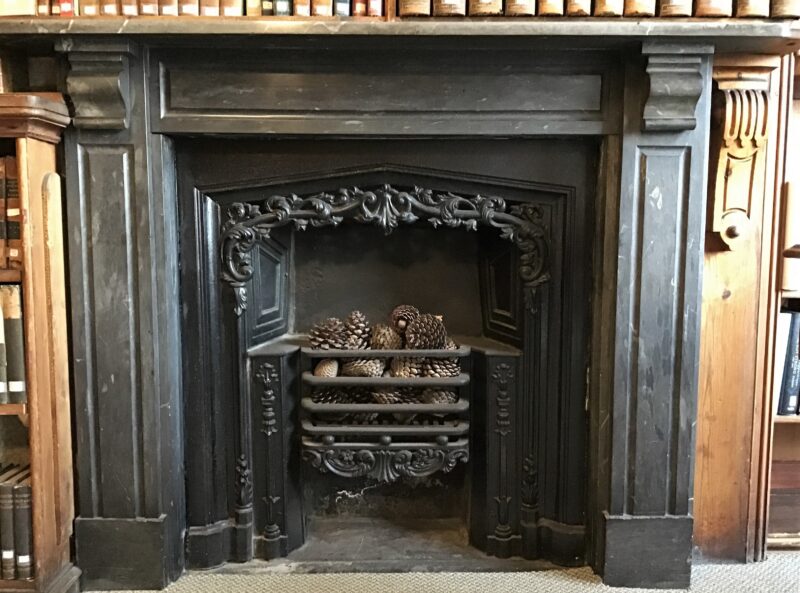
Not everyone, however, was happy with the decision. There were objections about carriages driving through the Gardens (YMCA clients would presumably have arrived on foot or bicycle), and the perceived exclusiveness of the Library. A letter to the Cornish Telegraph later referred to “the ‘class’ legislation which installed a lot of wealthy people in Morrab House.
The Library moved to its new premises in August 1889. The Cornishman reported that “a number of members seemed unwilling to say goodbye” to the old St John’s Hall rooms, and “lingered an hour after closing time.” Anxiety about fire from theatrical shows had prompted their move, and this was not left entirely behind. On the fine September evening when an evening illumination provided a finale for the official opening of the new Gardens, Morrab House remained “shrouded in darkness, the one dismal spot” on account of the Library staff, and “that haunting dread which has driven them from their old home [and] seems to hang over them still.”
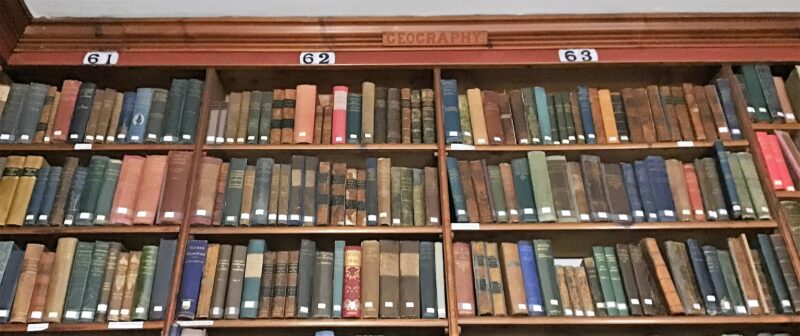
Despite this gloom, floor to ceiling shelves were constructed in most of the rooms. Most of these survive today, as do many of the original fittings throughout the house. You can still glimpse some of the Pidwell’s wallpaper on the walls behind the shelves, admire the marble fireplaces and the rose cornices on the ceiling, and still feel as though you are sitting in a beautiful family home.
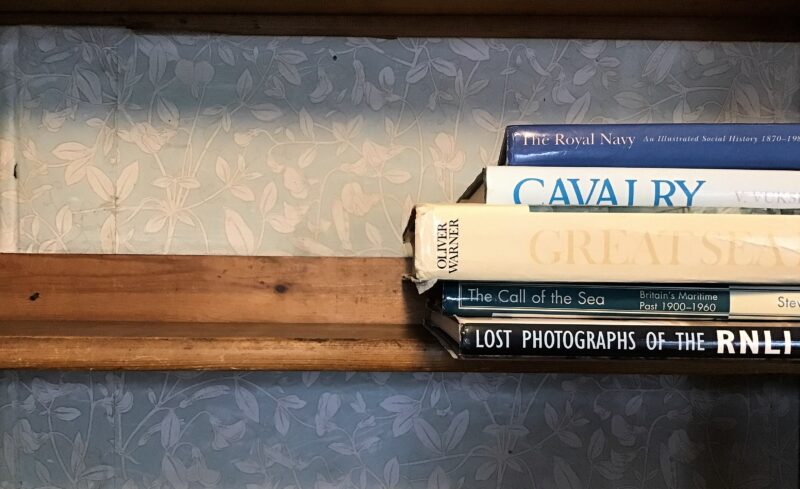
But the real problem at the spacious new premises in 1889 was that the rooms had to be filled. William Bolitho of Ponsandane came forward with a substantial bequest, to be spent on books costing at least two guineas each. Other major bequests and donations followed, perhaps the most significant donor – certainly in terms of volume – being the 1911 bequest of Prebendary Philip Hedgeland, Vicar of St Mary’s Church. Pick books from the shelves in any room – science, literature, classical or modern languages – and you are likely to find that they once belonged to him.
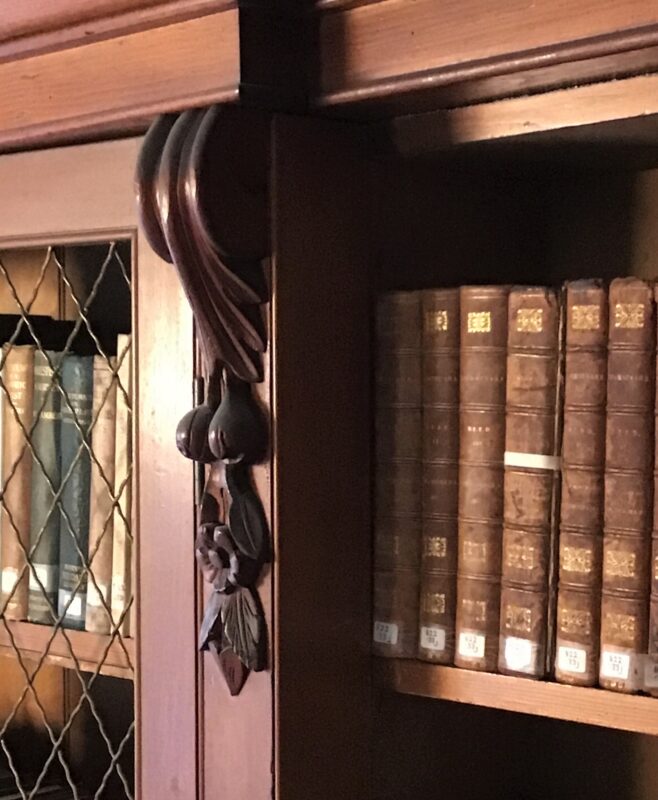
Since then, the Library has certainly had no problem filling its shelves – and although various changes have been made to the building, the original parts remain very much the same as they were in 1889. Lights and other fittings have been updated as times have changed, carpets have been laid (and taken back up again to reveal the wooden floors), wallpaper has been pasted on (and painted over) – and the books have migrated from shelf to shelf and from room to room; but Morrab Library’s quintessential essence remains. Even the major extension to the building in 2013, now housing our art room and Photographic Archive, served to only enhance this remarkable space: Samuel Pidwell’s Morrab House of 1841.
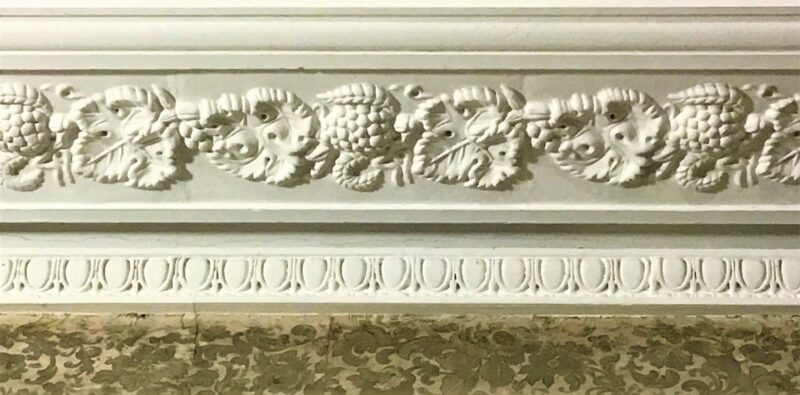
Perhaps the best way to end this blog is to quote the quintessential local author Arthur Quiller Couch:
‘There are hundreds of bigger and finer libraries, but few have a pleasanter tradition, and not one is so beautifully placed. Can a bookish man imagine anything more delightful than a library put together by the taste and care of generations of scholars and students, and set in a garden?’
We think not, Q; …we think not.
Linda Camidge
December 2021







 Figure 1
Figure 1















